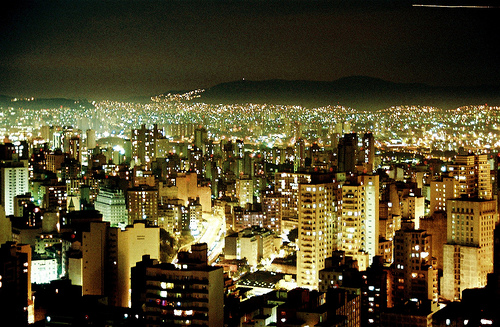
By Alana Gerson
Sector Risks
Sao Paulo’s electricity generation and transmission is part of a national single line interconnected grid connecting Brazil’s North and South parts. Approximately 85% of Brazil’s electricity is generated through hydropower (GENI, 2009), of which Sao Paulo consumes 17% (The World Bank, 2011). In 2009, Sao Paulo emitted 15 million tons of CO2, 76% of which was from the energy sector (United Nations, 2009).
A climate risk assessment (Mehrotra et al., 2009) of the energy sector in Sao Paulo shows reason for concern given projections for precipitation and temperature in the area combined with the modes of energy generation used in the region. Current trends predict a decrease in precipitation in the northern region of Brazil where the second largest dam, Belo Monte, is in development, while a 20% increase in frequency and intensity of precipitation is projected for the Southeastern region (Haggar, 2011). Brazil’s heavy reliance on hydropower, lack of diversification and infrastructure investment (Mili, 2002) make Sao Paulo, the largest city in Brazil, vulnerable to extreme climate events. For example, the occurrence of extended droughts similar to those in late 1990’s that resulted in a severe 60% depletion of water reservoirs significantly decreased the capacity to generate power and, thus, led to the Brazil energy crisis of 2001 (Schwieger, 2009).
Adaptation and Mitigation
Sao Paulo should focus on locally generating its own renewable energy through PV, wind, biomass, small hydro and possibly wave, establishing complete autonomy over its generation and transmission, reducing the risk of power outages and the elapse time for repairs while establishing an independent foundation for the city’s growing energy demand.
The partnership between GE and Eletropaulo, the largest utility company in Brazil and Sao Paulo’s service provider, to install a test smart grid metering infrastructure system furthers the potential for similar projects and investments for local generation in the future, thus reducing the need for new large generation plants currently being developed in the Northern part of Brazil (GE Digital Energy, 2011).
Sao Paulo’s Municipal Climate Change Policy calls for a GHG reduction of 30% by 2030 (IEA, 2008). Since 2008, through the Clean Development Mechanism, a little over 7% of Sao Paulo’s electricity has been generated through two thermoelectric power plants, Sao Joao and Bandeirantes (ICLEI, 2011) which has mitigated 7.4 million tons of CO2 through 2010 and will continue until 2018 (ICLEI, 2009). One of the many mitigation strategies Sao Paulo has been implementing to reduce the city’s dependency on fossil fuels 10% every year through 2018 (Sims, 2011) is installing solar power water heaters (C40 Climate Summit Sao Paulo, 2011).
Recommendation
1. Sao Paulo should decentralize and redistribute energy through local renewable energy generation, like PV, wind, biomass, small hydro, and possibly wave, mitigating large amounts of construction GHG emissions and costs, electricity loss through long transmission lines, and provide adaptive capacity for the future growth and development of the city.
2. Engineering feasibility studies should be conducted to distinguish viable locations for renewable energy development. In particular, small hydro-plants should be developed in the southern region of Brazil to be in closer proximity to the larger cities, eliminating loss of electricity through transmissions lines and mitigating the large amounts of methane expected to be produced through the current development of Belo Monte in the north.
3. To assist in the development of locally generated renewable energy, Sao Paulo should establish a Program for Renewable Energy Resources that would provide tax incentives and funding for renewable energy projects.
C40 Large Cities ‘ Climate Summit Sao Paulo 2011. Sao Joao and Bandeirantes Landfills. Retrieved 11.5.11. http://www.c40saopaulosummit.com/site/conteudo/index.php?in_secao=36&lang=3&in_conteudo=2
C40 Large Cities ‘ Climate Summit Sao Paulo 2011. Use of Solar Energy for Water Heating. (2011). Retrieved on 11.5.11 http://www.c40saopaulosummit.com/site/conteudo/index.php?in_secao=36&lang=3&in_conteudo=10
GE Digital Energy (2011). GE Smart Meters Help City of Sao Paulo Demonstrate. Retrieved on 11.5.11. http://www.gedigitalenergy.com/press/Eletropaulo/index.htm
Geni Global Energy Network Institute. (2009). Brazil Energy Issues. Retrieved on 11.5.11 http.www.geni.org.
Haggar, J., & Schepp, K. (2011). Desk Study: Impacts of Climate Change in the Pilot Country Brazil of the Coffee & Climate Initiative. Coffee and Climate Change. University of Greenwich.
ICLEI Local Governments for Sustainability. (2009). Turning pollution into profit: the Bandeirantes Landfill Gas to Energy Project. Retrieved on 11.5.11. http://www.iclei.org/fileadmin/user_upload/documents/Global/case_studies/ICLEI_Case_Study_Sao_Paulo_107_July_2009.pdf
International Energy Agency. (2010). Electricity Generation by Fuel. Retrieved on11.5.11 http://www.iea.org/stats/pdf_graphs/BRELEC.pdf
International Energy Agency (2008). Beyond the OECD-Brazil. Retrieved on 11.5.11 http://www.iea.org/country/n_country.asp?COUNTRY_CODE=BR
Mehrotra, S., C.E. Natenzon, A. Omojola, R. Folorunsho, J. Gilbride & C. Rosenzweig. (2009). Framework for city climate risk assessment. Washington, DC: World Bank.
Mili, Lamine. (2002)‚Ä®. Mitigating the Vulnerabilities of Critical Infrastructures in Developing Countries, World Bank Report. Retrieved on 12.11.11 http://www.nvc.vt.edu/lmili/docs/Mili,World%20Bank%20Report.pdf
Rosenzweig, C., Solecki, W. D., Hammer, S. A., & Mehrotra, S. (2011). Climate Change and Cities. New York: Cambridge University Press.
Schwieger, Scott. (Ed.). (2010). 2010 Brazil Energy Handbook. PSI Media Inc, Dec 2009. Retrieved on 11.5.11. http://www.psimedia.info/handbooks/Brazil_Energy_Handboook.pdf
Sims, B. (2011). Sao Paulo to Fuel 160 City Buses with Amyris’ Renewable Diesel. Retrieved 11.5.11. from Biodiesel Magazine http://www.biodieselmagazine.com/articles/7935/sao-paulo-to-fuel-160-city-buses-with-amyris-renewable-diesel
The World Bank/Urban Development and Local Government Unit. (2011). Urban Risk Assessments: An Approach for Understanding Disaster and Climate Risk in Cities. Retrieved on 11.5.11. https://www.citiesalliance.org/ca/sites/citiesalliance.org/files/UnderstandingUrbanRisk8-4-2011web.pdf
United Nations (2009). International Cooperation Among Cities: the C-40 Initiative. Retrieved on 11.5.11. http://www.un.org/esa/dsd/susdevtopics/sdt_pdfs/meetings/egm0809/vitali_C40_SP_UN_NY_Aug.pdf
This article is a product of Professor Shagun Mehrotra’s Climate Change and Cities class. Views expressed are entirely those of the individual author.